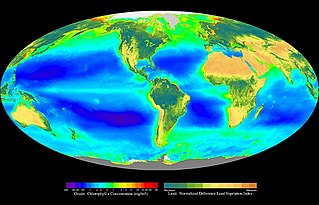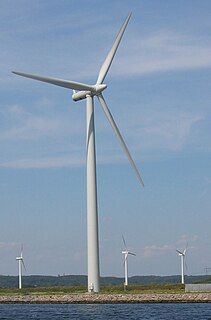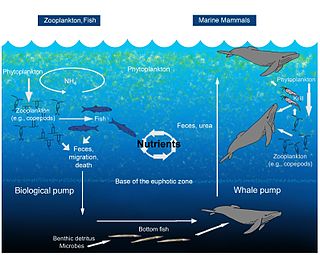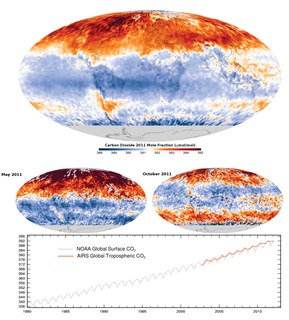This article needs additional citations for verification .(June 2008) (Learn how and when to remove this template message) |
The carbon cycle is the process by which carbon is exchanged between the four reservoirs of carbon: the biosphere, the earth, the air and water. Exchanges take place in several ways, including respiration, transpiration, combustion, and decomposition. The carbon balance, or carbon budget, is the balance of exchange between the four reservoirs.

The carbon cycle is the biogeochemical cycle by which carbon is exchanged among the biosphere, pedosphere, geosphere, hydrosphere, and atmosphere of the Earth. Carbon is the main component of biological compounds as well as a major component of many minerals such as limestone. Along with the nitrogen cycle and the water cycle, the carbon cycle comprises a sequence of events that are key to make Earth capable of sustaining life. It describes the movement of carbon as it is recycled and reused throughout the biosphere, as well as long-term processes of carbon sequestration to and release from carbon sinks.

The biosphere also known as the ecosphere, is the worldwide sum of all ecosystems. It can also be termed the zone of life on Earth, a closed system, and largely self-regulating. By the most general biophysiological definition, the biosphere is the global ecological system integrating all living beings and their relationships, including their interaction with the elements of the lithosphere, geosphere, hydrosphere, and atmosphere. The biosphere is postulated to have evolved, beginning with a process of biopoiesis or biogenesis, at least some 3.5 billion years ago.

Cellular respiration is a set of metabolic reactions and processes that take place in the cells of organisms to convert biochemical energy from nutrients into adenosine triphosphate (ATP), and then release waste products. The reactions involved in respiration are catabolic reactions, which break large molecules into smaller ones, releasing energy in the process, as weak so-called "high-energy" bonds are replaced by stronger bonds in the products. Respiration is one of the key ways a cell releases chemical energy to fuel cellular activity. Cellular respiration is considered an exothermic redox reaction which releases heat. The overall reaction occurs in a series of biochemical steps, most of which are redox reactions themselves. Although cellular respiration is technically a combustion reaction, it clearly does not resemble one when it occurs in a living cell because of the slow release of energy from the series of reactions.
Debate about 're-balancing the carbon cycle' arises from a concern that use of fossil fuels, which has accelerated since the start of the industrial revolution, has caused carbon to accumulate in the atmosphere. Levels of CO2 in the atmosphere are estimated to have risen from 280 ppm to 418 ppm(And rising) since 1800 and this is linked to global warming. It is therefore argued that the carbon cycle should be re-balanced by reducing the amount of CO2 in the atmosphere.

Carbon dioxide is a colorless gas with a density about 60% higher than that of dry air. Carbon dioxide consists of a carbon atom covalently double bonded to two oxygen atoms. It occurs naturally in Earth's atmosphere as a trace gas. The current concentration is about 0.04% (410 ppm) by volume, having risen from pre-industrial levels of 280 ppm. Natural sources include volcanoes, hot springs and geysers, and it is freed from carbonate rocks by dissolution in water and acids. Because carbon dioxide is soluble in water, it occurs naturally in groundwater, rivers and lakes, ice caps, glaciers and seawater. It is present in deposits of petroleum and natural gas. Carbon dioxide is odorless at normally encountered concentrations. However, at high concentrations, it has a sharp and acidic odor.

Global warming is a long-term rise in the average temperature of the Earth's climate system; an aspect of climate change shown by temperature measurements and by multiple effects of the warming. Though earlier geological periods also experienced episodes of warming, the term commonly refers to the observed and continuing increase in average air and ocean temperatures since 1900 caused mainly by emissions of greenhouse gases (GHGs) in the modern industrial economy. In the modern context the terms global warming and climate change are commonly used interchangeably, but climate change includes both global warming and its effects, such as changes to precipitation and impacts that differ by region. Many of the observed changes in climate since the 1950s are unprecedented in the instrumental temperature record, and in historical and paleoclimate proxy records of climate change over thousands to millions of years.
'Carbon cycle re-balancing' is a useful name for a group of environmental policies listed below. The name gives a specific reason for adopting these policies. Related names, including pleas for sustainable development and participation in the green movement are politics-based rather than science-based.
Sustainable development is the organizing principle for meeting human development goals while simultaneously sustaining the ability of natural systems to provide the natural resources and ecosystem services upon which the economy and society depend. The desired result is a state of society where living conditions and resources are used to continue to meet human needs without undermining the integrity and stability of the natural system. Sustainable development can be defined as development that meets the needs of the present without compromising the ability of future generations.
- Carbon offset - for example by photosynthesis (e.g. in new forests)
- Carbon capture and storage - extraction of CO2 and placing it underground or underwater
- Carbon capture and transformation - extraction of CO2 and reacting it with hydrogen via renewable energy electrolysis to create methane as an energy store/carrier. Low to neutral CO
2 cycle - Sustainable energy - a shift from fossil fuels energy to wind power and solar power
- Nuclear power - as an alternative to fossil fuels
- Sustainable design - to reduce inputs and outputs of energy
- Sustainable transport - to reduce reliance on fossil fuels

A carbon offset is a reduction in emissions of carbon dioxide or other greenhouse gases made in order to compensate for emissions made elsewhere. Offsets are measured in tonnes of carbon dioxide-equivalent (CO2e). One tonne of carbon offset represents the reduction of one tonne of carbon dioxide or its equivalent in other greenhouse gases.

Carbon capture and storage (CCS) is the process of capturing waste carbon dioxide usually from large point sources, such as a cement factory or biomass power plant, transporting it to a storage site, and depositing it where it will not enter the atmosphere, normally an underground geological formation. The aim is to prevent the release of large quantities of CO
2 into the atmosphere from heavy industry. It is a potential means of mitigating the contribution to global warming and ocean acidification of carbon dioxide emissions from industry and heating. Although CO
2 has been injected into geological formations for several decades for various purposes, including enhanced oil recovery, the long term storage of CO
2 is a relatively new concept. Direct air capture is a type of CCS which scrubs CO
2 from ambient air rather than a point source.

Sustainable energy is a principle in which human use of energy "meets the needs of the present without compromising the ability of future generations to meet their own needs." Sustainable energy strategies generally have two pillars: cleaner methods of producing energy and energy conservation.
Burning domestic refuse to generate power can be promoted as a recycling, and therefore sustainable, policy. But from a carbon cycle re-balancing standpoint it is better to compost as much domestic refuse as possible.

Recycling is the process of converting waste materials into new materials and objects. It is an alternative to "conventional" waste disposal that can save material and help lower greenhouse gas emissions. Recycling can prevent the waste of potentially useful materials and reduce the consumption of fresh raw materials, thereby reducing: energy usage, air pollution, and water pollution.
A policy is a deliberate system of principles to guide decisions and achieve rational outcomes. A policy is a statement of intent, and is implemented as a procedure or protocol. Policies are generally adopted by a governance body within an organization. Policies can assist in both subjective and objective decision making. Policies to assist in subjective decision making usually assist senior management with decisions that must be based on the relative merits of a number of factors, and as a result are often hard to test objectively, e.g. work-life balance policy. In contrast policies to assist in objective decision making are usually operational in nature and can be objectively tested, e.g. password policy.

Compost is organic matter that has been decomposed in a process called composting. This process recycles various organic materials otherwise regarded as waste products and produces a soil conditioner.








